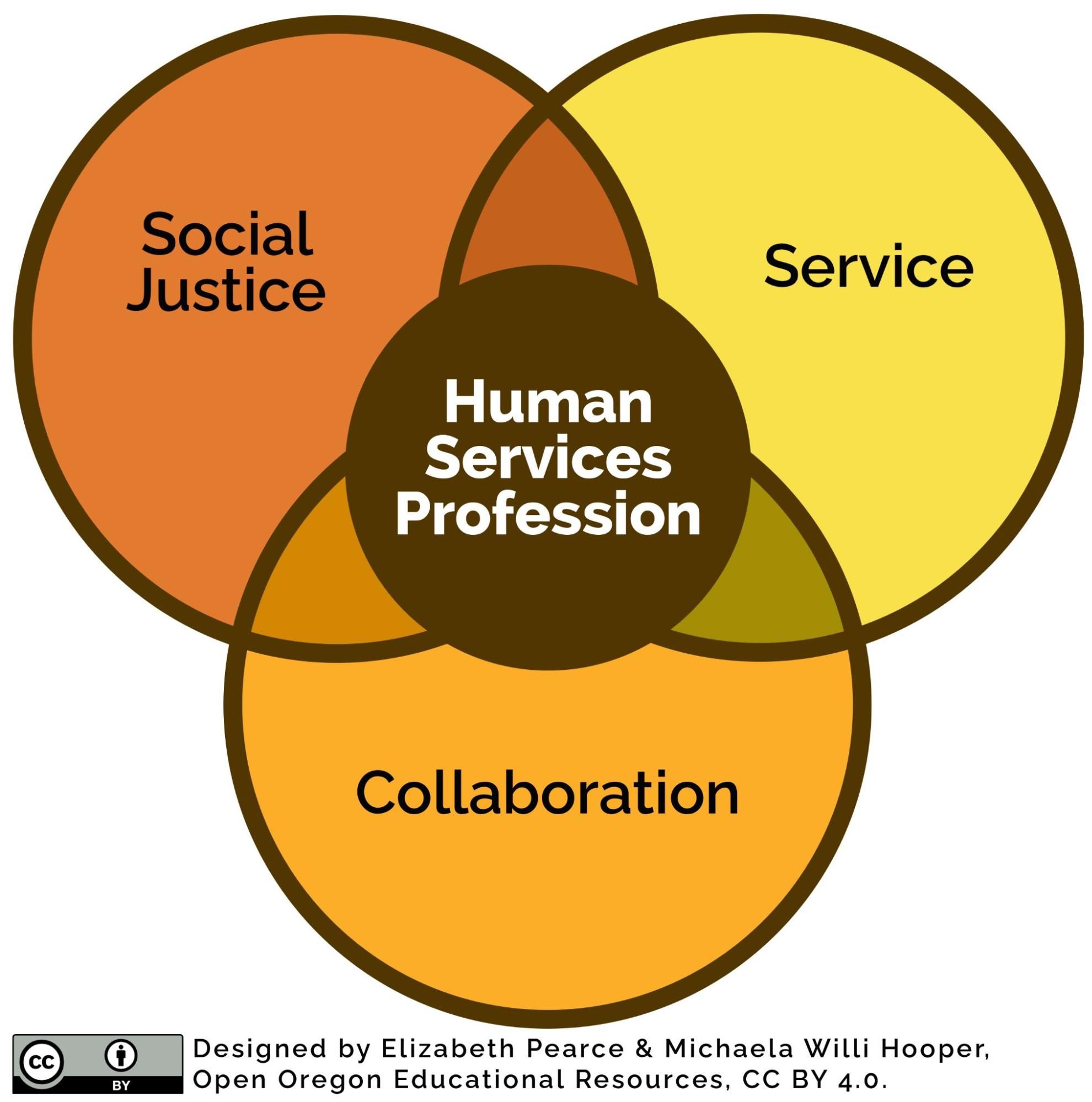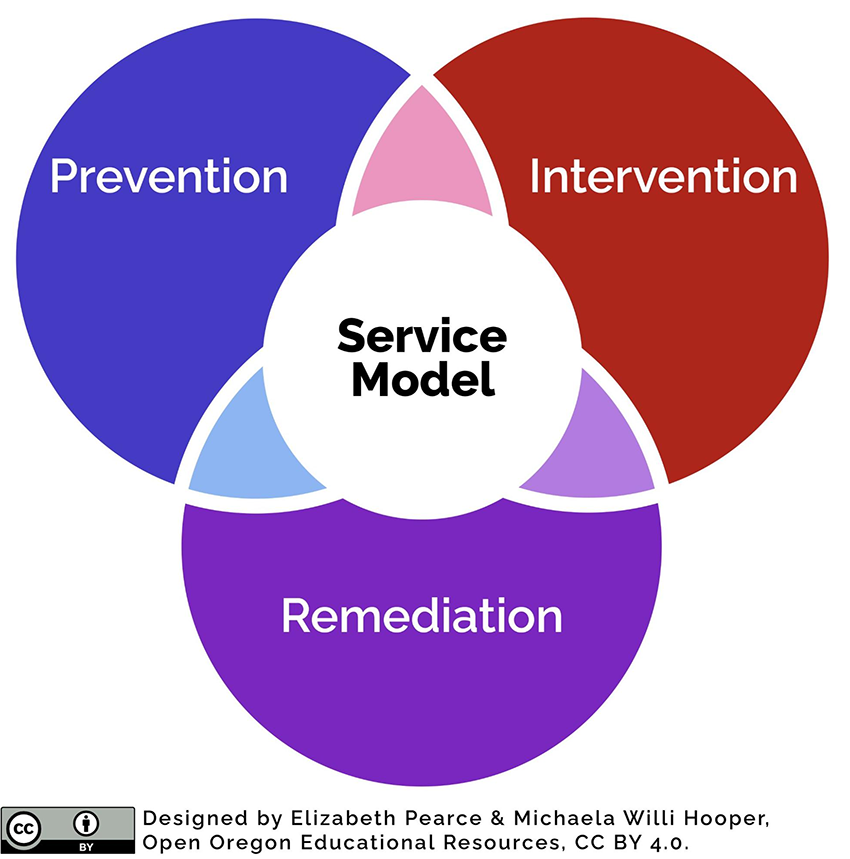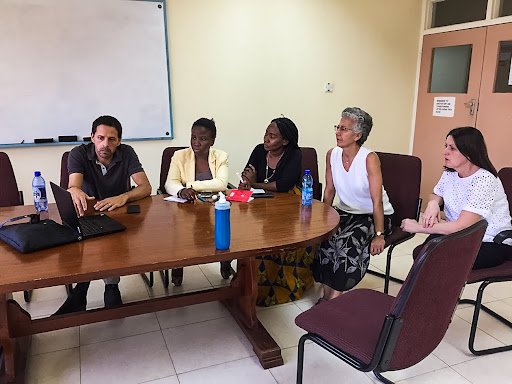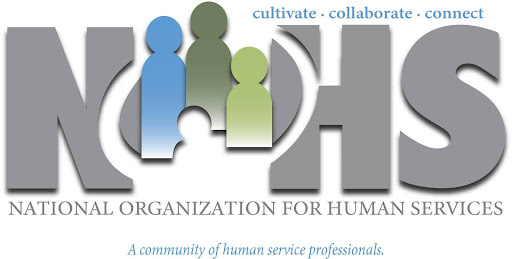1.2 What Is Human Services?
Some people may be unfamiliar with human services as a profession. Human services is a broad interdisciplinary field that aims to meet people’s needs, prevent and remedy problems, and improve their quality of life. It promotes accessibility, accountability, and coordination among professionals and agencies in service delivery. Human services help people achieve stability, including basic needs like food and shelter, counseling, and substance abuse treatment. It is a crucial component of society’s social welfare system, centering equity (figure 1.1). Human services professionals rely on the following areas to meet the needs of their clients:
- an interdisciplinary knowledge base that includes prevention, intervention, and remediation;
- a commitment to the delivery of essential services and working with other agencies to improve people’s overall quality of life; and
- a focus on equity and social justice to optimize the potential of individuals and groups (Kincaid, 2009).

The broad definition of this discipline means that many jobs and careers fit under the umbrella of human services. People motivated to help others find themselves together in this field even though they work in a wide range of settings, including schools, medical offices and hospitals, private nonprofit agencies, and governmental services.
For example, people who work in human services perform functions that help people resolve life’s problems, such as housing insecurity and homelessness, unemployment, food insecurity, addictions, custody, or the social and emotional sides of loss, tragedy, and illness. They provide services helping people with adoptions, fostering children, parenting, mental health challenges, dealing with grief and loss, and other life transitions.
Interdisciplinary and Collaborative Approach
Human services is grounded in the context of human development and human organizational behavior, or how people behave in groups. Human services requires a uniquely interdisciplinary approach, meaning multiple disciplines contribute to the profession.
This broad understanding comes from multiple fields, such as but not limited to:
- human development and family sciences
- psychology
- sociology
- early childhood development and education
- public health and nutrition
- communications
- criminal justice
- restorative justice
- community organizing or grassroots movements
- for-profit organizations
- nonprofit organizations
- public agencies
While the professionals in human services may have a specialized focus in one of these areas, they will also have enough broad-based knowledge and experience to draw on when needed for work in a wide variety of environments.
Collaboration is an essential part of human services and means that many agencies and services must work together to best serve individuals, families, and groups. Just like the image in figure 1.1, the human services professional must piece together a solution that serves the entire person. Professionals work to make the delivery of services as smooth and complete as possible. Planning; communicating; focusing on others’ experiences, needs, and strengths; and being other-centered are important to delivering human services. There are times when a human service professional may need to step aside or refer a client to another service that can more fully support the client in their goals.
Being knowledgeable about other services and being intentional about asking questions when one doesn’t know the answers are highly valued skills in human services. The combination of collaboration, communication, and knowledge can lead to smoother service delivery, which in itself benefits others. All of these factors contribute to helping people use human services to achieve the best quality of life possible.
The Human Services service model focuses on preventing problems, intervening in problems, and remediating problems. As you learn more, consider which mode you might prefer most.
Human services professionals’ primary work is helping people solve their life problems across three stages: preventing problems, intervening in problems, and remediating problems, as shown in figure 1.2.

The human services field includes professionals who specialize in only one aspect of the service model. As you read this text, consider your career from the lens of prevention, intervention, and remediation. Where do you want to focus?
- Prevention: Professionals may work in education, public health, or policy planning. It also includes helping individuals prevent the recurrence of problems through planning, budgeting, problem-solving, or counseling support.
- Intervention: Professionals involved in intervention help people solve problems as they occur. When working in intervention, professionals can provide intervention at the policy and programmatic levels, and when professionals work in program design and creation at programmatic levels to support creating programs that provide the framework for prevention and remediation services. Professionals may work at the policy level to design and create needed services, or they may work individually to assist people in accessing services and stabilizing their lives.
- Remediation: Professionals in the area of remediation work with programs and policies that involve chronic problems, such as addiction and criminal behavior. To help people rehabilitate themselves, human services workers use a strengths-based approach, which involves using the strengths of individuals, families, and communities to solve problems.
Equity, Equality, Social Justice, and Inclusion
The human services field is grounded in the principles of equality, social justice, and inclusion. Our ethical duties require us to incorporate these values into our work and decision-making processes in prevention, intervention, and remediation. Chapter 3 and Chapter 4 will delve deeper into how these lenses are employed in our field. Understanding these concepts early on is essential, as they will shape our discussions of human services. Ethical Standard 10 of the National Organization for Human Services mandates that professionals provide services without discrimination or preference to any group, especially those historically oppressed.
However, these words can seem hollow without concrete examples. In upcoming chapters, we will explore how equity, equality, social justice, and inclusion manifest in the three modes of service delivery. Establishing clear definitions of these terms will provide a framework for our future discussions.
Equity involves acknowledging and addressing imbalances caused by bias or systemic structures, as we don’t all start from the same place.
Equality is one of the central principles of democracy. It is based on the belief that all people should have the same opportunities to be successful and have a productive, enjoyable life. Equality is rooted in fairness, since it is linked to the notion that everyone will be able to achieve based on their efforts and contributions to society instead of their status or position.
Inclusion is the active, intentional, and ongoing engagement with diversity. Inclusion is seen as a universal human right. It aims to embrace all people regardless of race, gender, or disability, as well as medical or other needs. It is about giving equal access and opportunities and eliminating discrimination and intolerance. It affects all aspects of public life.
Social Justice is the explicit effort toward every person receiving and obtaining equal economic and social opportunities while removing systemic barriers.
As we progress in these chapters, remember that our intersecting identities will be crucial in shaping our approach toward equity, inclusion, and social justice. It’s important to acknowledge that our intentions may not always align perfectly with the impact we have, but we must take ownership of our actions and strive to improve our skills in this regard. We can positively impact and create a more just and equitable society with confidence and a willingness to learn.
Human Services and Related Fields
An associate’s degree in human services can lead to bachelor’s, master’s, and doctoral degrees in multiple fields, including human services, social work, counseling, public health, psychology, or sociology. More discussion of degrees, licenses, and careers will appear in Chapter 9. Collaboration across disciplines is common, as visualized in figure 1.3, and multidisciplinary teams are often required to support clients with high needs.

The Distinction between Human Services and Social Work
Human services is a relatively new profession, having emerged from social welfare work in the 1950s and 1960s. Social work became a more prominent field in the same era, and these two fields are intertwined. Social work and human services focus on helping people both individually and in groups, and they emphasize social justice, which is the view that everyone deserves economic, political, and social rights and opportunities that lead to equal outcomes.
One key distinction between human services and social work is that social work has a specific licensing and credentialing system, and human services does not. Psychology, public health, education, and sociology are other fields related to human services. If you are considering human services as a career, you may want to look into these other fields as well.
Professionals from both fields may work side by side in settings such as addiction treatment centers, incarceration programs, government agencies, and nonprofit agencies. Both professions can work with individuals, groups, and communities to perform advocacy work, community organizing, and even policy work. However, access to certain levels of clients and scopes of practice require certain degrees and training programs. Depending on these requirements, you would need to consider either the human service field or look into social work as an option. However, an associate-level move to the bachelors, masters, or doctoral level of education is not always necessary to do the work that you want to do.
Sociology and Psychology
Human services and social work are both applied fields with a focus on working with people, while psychology and sociology are more focused on theoretical understandings of social problems. Both are important foundations for the applied fields, but psychology and sociology dive deeper into science, research, and theory than do human services. Psychology is focused on the study of the individual human mind, the way it functions, and how it affects behavior. Sociology focuses more on studying society’s structure, development, and functioning.
The study of social problems, which is fundamental to human services, comes from the field of sociology. Sociologists research, teach, study, and analyze organizational and societal behavior, including social problems and how they affect people and society.
Psychology is another field that has specific credentials associated with higher-level degrees. Students who wish to become psychologists typically think about earning a doctoral degree, during which they might treat patients in a clinical setting or conduct diagnosis and assessments in settings such as schools or prisons. Others will earn a doctorate to perform scientific research related to the brain and behavior.
Students sometimes ask about becoming a counselor or a mental health therapist. These are also roles certified and licensed by states and other jurisdictions. It is important to look at the certification requirements in the state where you reside or plan to reside. Examples of these roles include Licensed Marriage Family Therapist (LMFT) and Licensed Professional Counselor (LPC). These roles almost always require a master’s degree and sometimes a doctoral degree. An undergraduate degree in human services, psychology, social work, or a related field prepares students for these advanced degrees.
Criminal Legal System
The criminal legal system is another broad field that encompasses all aspects of the systems related to law enforcement, including social processes such as laws, policies, and the practices of the court systems. Related jobs include police officers, lawyers, parole and probation officers, CASA (court-appointed special advocates), case managers, and correctional officers. Some working in the helping professions may also be placed within the criminal legal system, such as social workers, counselors, behavioral aides, and addiction counselors. These helpers may be embedded within a jail or prison, but they might specifically work with people in other parts of the justice system too.
People interested in the remediation aspect of criminal legal work are often inspired by the grounding principles of human services. Students of human services who have also studied the criminal legal system may head toward careers in parole, probation, or other helping roles within a correctional facility.
Public Health, Education, and Early Childhood Education
Public health, education, and early childhood education are considered helping careers and are application based, just like human services. People with human services and public health degrees might end up working side by side with one another in organizations that are focused on people’s health, but there will likely be more specialized jobs in that same organization that require a public health degree. An increased focus on public health issues during the COVID-19 pandemic has resulted in the overlap of multiple
Students who want to work with children of varying ages may be interested in the education or early childhood education fields. There is certainly an overlap with the human services field, because there are many families with children who seek help from human services professionals. A primary difference between teaching children and serving families with children is that a teacher is responsible for designing and implementing a curriculum for a group of children and typically spends eight hours per day with those students. The human services professional is more likely to work with children when their parents are present and for shorter periods of time.
For example, someone with a human services degree might be a family support specialist for Head Start or another early childhood education program. Teachers in public schools must be certified by the states they live in; and states vary whether this certification is completed at the bachelor’s or the master’s degree level. This applies to K-12 teaching consistently and, in some states, to early childhood teaching.
Another lesser-known career path that has become much more popular in the last few years has been that of home visitors. Home visiting itself has been an informal practice in many cultures around the world and includes lactation support, nutritional guidance for babies and parents, parenting advice, attachment questions, and much more.
Versions of home visiting programs started about forty years ago with nurses in formal settings, but that required a higher level of education that excluded home service providers. This has changed and expanded in recent years to include a whole new set of excellent professionals in programs such as Early Head Start and even programs explicitly working with BIPOC teen parents. These professionals have extensive training in family support systems and child support needs.
Professional Associations and Licensing
Human services, social work, psychology, sociology, public health, education, and early childhood education are similar in that they are all fields involved with helping or studying individuals and society. In addition, they are all professions.
Professional fields are defined by their requirement of long-term education and training. Some have licensure systems as well as requiring an undergraduate or graduate degree. In addition, professions are distinguished by having a professional association and a code of ethics that members use in their work.
Learn more about resources that are critical to human services workers who want to stay up-to-date on research, effective strategies, and the problems facing the people we serve by exploring the following links:

Earning a degree, participating in a professional organization, and taking advantage of internship opportunities are all significant steps in preparing for the future. As you progress through future chapters, you can better understand the ethical standards and principles that guide human service providers. Additionally, you will learn about the various types of credentials and qualifications available to individuals in this field, as well as potential career paths and opportunities for licensure. By delving into these topics, you will be better equipped to navigate the complex human services landscape and make informed decisions about your professional development.
Licenses and Attributions
Open Content, Original
“What Is Human Services?” by Elizabeth B. Pearce is licensed under CC BY 4.0. Revised by Martha Ochoa-Leyva.
Figure 1.1. “Human Services Profession” by Elizabeth B. Pearce and Michaela Willi Hooper is licensed under CC BY 4.0.
Figure 1.2. “Service Model” by Elizabeth B. Pearce and Michaela Willi Hooper is licensed under CC BY 4.0
Open Content, Shared Previously
Figure 1.3. A multidisciplinary team discussion in Malawi by Community Eye Health is licensed under CC BY-NC 2.0.
All Rights Reserved
Figure 1.4. “NOHS Logo” from https://www.nationalhumanservices.org/ used under fair use.
a professional field focused on helping people solve their problems.
a paid career that involves education, formal training and/or a formal qualification.
well-being
provision of what each individual needs in order to receive and obtain equal opportunities.
develop strategies that fend off problems
action taken to improve a situation or address a problem
the correction or reversing of actions or behaviors
viewpoints and efforts toward every person receiving and obtaining equal economic and social opportunities; removal of systemic barriers.
conditions that might cause someone to become houseless or that are hazardous to the health of occupants of a home
the use of multiple disciplines, or knowledge branches, working together to solve problems.
an alternative approach to criminal justice that centers the survivor, taking into account what they need to experience healing. It also involves the participation of the perpetrator, requiring them to recognize the harm they did in the process of holding them accountable.
the act of working with others.
a model that looks at three ways to help people solve problems.
relearn or reform behaviors
the practice of using the strengths of individuals, families, and communities to solve problems.
socially created and poorly defined categorization of people into groups on basis of real or perceived physical characteristics that has been used to oppress some groups
the socially constructed perceptions of what it means to be male, female or nonbinary in the way you present to society
A physical, cognitive or emotional condition that limits or prevents a person from performing tasks of daily living, carrying out work or household responsibilities, or engaging in leisure and social activities.
an academic rank conferred by a college or university after completion of a specific course of study.
moral principles.
a credit class in which students apply theory to practice by using what you have learned in coursework in a real world setting with a supervisor/mentor who is invested in the student’s growth and development.
Agreed upon level of quality in selected areas.

